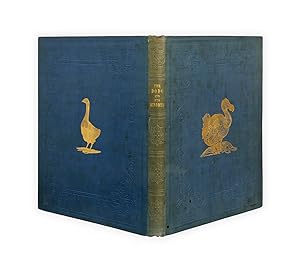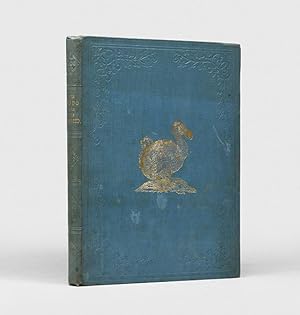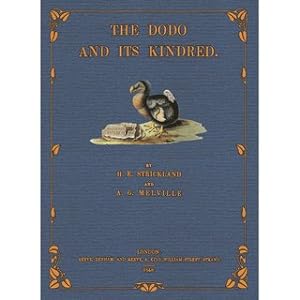dodo kindred history affinities von strickland hugh (3 Ergebnisse)
Produktart
- Alle Produktarten
- Bücher (3)
- Magazine & Zeitschriften
- Comics
- Noten
- Kunst, Grafik & Poster
- Fotografien
- Karten
-
Manuskripte &
Papierantiquitäten
Zustand
- Alle
- Neu
- Antiquarisch/Gebraucht
Einband
- alle Einbände
- Hardcover (1)
- Softcover
Weitere Eigenschaften
- Erstausgabe (1)
- Signiert (1)
- Schutzumschlag
- Angebotsfoto
Land des Verkäufers
Verkäuferbewertung
-
G.MELVILLE. The Dodo and its Kindred; or, the History, Affinities and Osteology of the Dodo, Solitaire and other extinct Birds of the Islands Mauritius, Rodriguez, and Bourbon
Verlag: London: Reeve, Benham, and Reeve 1848., 1848
Anbieter: Bernard Quaritch Ltd ABA ILAB, London, Vereinigtes Königreich
Signiert
Large 4to, pp.[10], 141, [1], [12 (advertisements)], with a half-title, a hand-coloured lithograph frontispiece by Catherine Strickland and Vincent Brooks after Roelant Savery, an engraved vignette on the title-page, seventeen plates, including one further hand-coloured lithograph, two 'papyrograph' views, and 11 lithographs of skeletons (on thick paper, somewhat foxed, as is plate II), and numerous illustrations within the text; errata slip tipped in at the end; extra-illustrated with different version of Plate II (signed 'CS 1852'), and a printed offprint: 'Notice of an Original Painting' of a Dodo, by W.G.Broderip, pp.[55]56, dated in manuscript 13 April 1853; from the library of the Strickland family at Apperly Court, with the armorial bookplate of Henry Eustatius Strickland (17771865), and the red booklabel of Hugh Edwin Strickland dated 1853, with one marginal pencil note on p.8; a very good copy in the original blue cloth, front cover blocked in gilt with a dodo, rear cover block in gilt with a solitaire.An extra-illustrated family copy of the first scientific monograph on the dodo, and a related flightless bird, the Rodrigues solitaire, with the bookplates of the author and his father. 'These singular birds furnish the first clearly attested instances of extinction of organic species through human agency and many species of animals and of plants are now undergoing this inevitable process of destruction before the ever-advancing tide of human population' (p. 5). In Part I Strickland summarised the historical, pictorial, and scant material evidence of the dodo; for Part II he enlisted Arthur Gordon Melville to analyse the skeletons. Recognising that the success of the work would depend on the quality of the illustrations, he enlisted the help of his wife Catherine Dorcas Maule (née Jardine) (they had encountered Savery's pictures of the bird while on their honeymoon in 1845) and employed in several plates his own refinement of the anastatic printing process, which he called 'papyrography'. Plates II, III, III* IV and IV* were printed anastatically; Catherine Strickland drew the frontispiece and plate IV, and executed the lithography on plates III and III*. In the present copy there is added a second, seemingly unrecorded, version of Plate II, signed 'CS' (presumably also her). After Oxford, Hugh Edwin Strickland (18111853) devoted his energies to natural history and geology, publishing a stream of scientific articles in the 1830s and 40s; this was his most substantial work. In 1853 he became 'a martyr both to science and to progress' (Oxford DNB), when he was struck by a train while inspecting the strata in a railway cutting. Fine Bird Books, p. 145; Nissen IVB 900. Language: English.
-
The Dodo and its Kindred: or the history, affinities, and osteology of the dodo, solitaire, and other extinct birds of the islands Mauritius, Rodriguez and Bourbon.
Verlag: London: Reeve, Benham, and Reeve, 1848, 1848
Anbieter: Peter Harrington. ABA/ ILAB., London, Vereinigtes Königreich
Erstausgabe
First edition of this finely illustrated work. This copy has a superb provenance: with the bookplate of naturalist Sir William Jardine and his daughter Catherine Dorcas Maule Strickland, the author's wife. Strickland provides a comprehensive history and external description of the dodo, while the physician Melville analyzed the anatomy. A sparkling copy, rarely found in such collectible condition. With this important rediscovery of the extinct and largely forgotten dodo, Strickland set out to prove anthropogenic species loss and declared that "these singular birds. furnish the first clearly attested instances of extinction of organic species through human agency" (p. 5). To produce this monograph and support his claim about the reality of the bird Strickland gathered "historical, pictorial and anatomical evidence" (Barrow, p. 54). He reviewed fifteen original and independent accounts of the bird and went on to analyse five oil paintings of the species. Finally, he "turned to a discussion of the bird's meager surviving fragments: a foot in the British Museum, a cranium in the Gottorf Museum in Copenhagen, and a desiccated head and foot in the Ashmolean Museum in Oxford. The latter two fragments were all that remained of a once complete specimen that had decayed over the course of a century and barely escaped destruction during a bout of spring cleaning at the museum" (ibid.). The Dodo and its Kindred shows the "present state of the knowledge of the Didinae, in order to remove the many erroneous statements which are current, and to restore the lost organisms to their rank in the natural system" (publisher's catalogue). In Victorian fiction the dodo emerges most famously in Alice in Wonderland (1865), employed by Carroll as a caricature of himself. Hugh Edwin Strickland (18111853) was a natural historian, geologist, ornithologist, and member of the British Association for the Advancement of Science committee alongside Charles Darwin and Richard Owen. Strickland found his wife, Catherine Dorcas Maule (18251888), through his interest in natural history. He met "Sir William Jardine, bt, at the British Association for the Advancement of Science meeting at Glasgow in 1840, having previously corresponded with him on ornithological topics. On 23 July 1845 he married Jardine's second daughter, Catherine Dorcas Maule. She assisted both her father and her husband with drawings of birds, some reproduced anastatically in Jardine's Contributions to Ornithology (184853). Stricklandwas fatally wounded when struck by a train while geologizing near Clarborough Tunnel in 1853" (ODNB). Prince Albert, Sir William Jardine, the ornithologist John Gould, natural history artist Prideaux John Selby, engraver William Home Lizars, and cartographer John Arrowsmith are found in the small list of 124 subscribers. Fine Bird Books, p. 145; Nissen IVB 900. Mark V. Barrow, Nature's Ghosts: Confronting Extinction from the Age of Jefferson to the Age of Ecology, 2011. Folio. Original light blue cloth, spine lettered in gilt, gilt stamp of dodo on front cover and Rodrigues solitaire on back cover, spine and covers elaborately stamped in blind, yellow surface-paper endpapers, top edge gilt. Housed in a dark blue cloth flat-back box by the Chelsea Bindery. With hand-coloured lithographed frontispiece of a dodo by Vincent Brooks after Roelandt Savery, heightened with gum arabic, and 17 lithographed and anastatically-printed plates, including on folding and another hand-coloured, wood-engraved illustrations in the text. A few minor marks to covers, scattered foxing, text block cracked between pp. 50-1. A splendid copy.
-
The Dodo and its Kindred History, Affinities, and Osteology of the Dodo, Solitaire and other extinct Birds of the Islands of Mauritius, Rodriguez, and Bourbon
Verlag: Fines Mundi GmbH Saarbrücken, 2022
Anbieter: Versandantiquariat Nussbaum, Bernkastel-Kues, RP, Deutschland
Buch
Zustand: Wie neu. XII, 141 pages With 15 plates, partly coloured and some illustrations in text new / Modernes Schriftbild Sprache: Englisch Gewicht in Gramm: 1350 30,5 x 22,4 cm, gebundene Ausgabe Faksimile-Reprint der Ausgabe 1848 London, Reeve, Benham, and Reeve.




